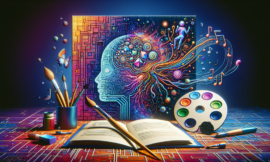In the world of technology, a few buzzwords pop up more frequently than others: Artificial Intelligence (AI), Machine Learning (ML), and Generative AI (GenAI). While these terms often get thrown around in tech circles, understanding how they relate to each other can be a bit like unravelling a complex puzzle. So, let’s dive into this exciting trio and discover how they work together to create some of the most ground-breaking innovations of our time.
Artificial Intelligence (AI): The Big Picture
Imagine a futuristic robot that can chat with you, solve complex problems, and even drive your car. That’s AI in action! At its core, Artificial Intelligence is all about simulating human intelligence in machines. It’s the grand umbrella under which everything related to intelligent machines falls. AI is about making machines smart enough to perform tasks that typically require human smarts—like understanding natural language, recognizing faces, or making decisions.
Within the realm of AI, there are two main categories:
- Narrow AI (Weak AI): Think of Narrow AI as a specialist—like a savvy search engine or a helpful virtual assistant. It’s designed for specific tasks and excels at them but doesn’t venture beyond its programmed expertise.
- General AI (Strong AI): This is the stuff of science fiction. General AI would have the cognitive flexibility and understanding of a human. It’s not just a specialist; it’s a jack-of-all-trades, capable of performing any intellectual task that a human can.
Machine Learning (ML): The Learning Machine
Now, let’s zoom in on Machine Learning, a crucial piece of the AI puzzle. ML is a subset of AI that focuses on training machines to learn from data. Instead of programming a computer with explicit instructions, we feed it data and let it figure out patterns and make predictions on its own.
Here’s how ML works in a nutshell:
- Supervised Learning: Picture a teacher guiding a student through practice problems. In supervised learning, the machine is trained on labeled data—data with known outcomes. It learns to predict the right answers based on this guidance.
- Unsupervised Learning: This is like letting a student explore and discover patterns on their own. With unsupervised learning, the machine works with unlabeled data and tries to identify patterns or groupings without explicit instructions.
- Reinforcement Learning: Imagine a game where a player learns through trial and error, adjusting strategies based on feedback. Reinforcement learning involves a machine learning system that gets rewards or penalties based on its actions and learns to optimize its strategy over time.
Generative AI (GenAI): The Creative Genius
Enter Generative AI, a fascinating and somewhat magical branch of AI. While AI and ML are often about analyzing and predicting, Generative AI is about creating. It’s the technology behind generating new, original content that feels as though it could have been made by humans.
Generative AI uses some cool techniques:
- Generative Adversarial Networks (GANs): Think of GANs as a creative duel between two neural networks. One (the generator) tries to create new data that looks real, while the other (the discriminator) judges whether the data is authentic. They compete and improve through this back-and-forth process.
- Variational Autoencoders (VAEs): VAEs are like artists learning to draw from a specific style. They learn the distribution of data and use this knowledge to generate new, similar data.
- Transformers: These are the rock stars of natural language processing. Models like GPT (Generative Pre-trained Transformer) use transformers to generate human-like text, creating everything from poetry to code based on the context they’re given.
How They All Fit Together
So, how do these pieces fit together?
- AI and ML: Machine Learning is a key player within the AI universe. While AI is about simulating human intelligence in machines, ML is the toolkit that enables machines to learn and adapt based on data. It’s like having the software that powers the intelligence in AI.
- AI and GenAI: Generative AI is a creative branch of AI. While AI encompasses a broad range of intelligent behaviors, GenAI focuses on creating new and original content. It’s a showcase of how AI can extend beyond analysis and prediction to innovation and creativity.
- ML and GenAI: Generative AI often relies on machine learning techniques to generate its content. Whether it’s GANs, VAEs, or transformers, these ML methods are the engines driving the creative capabilities of GenAI.
Wrapping It Up
Understanding AI, ML, and GenAI is like unlocking a new level in the tech world. Each plays a distinct role, but together, they create a powerful synergy that’s reshaping industries, driving innovation, and opening up exciting possibilities for the future. As these technologies continue to evolve, we can look forward to even more incredible advancements that blend intelligence, creativity, and learning in ways we’re just beginning to explore.

